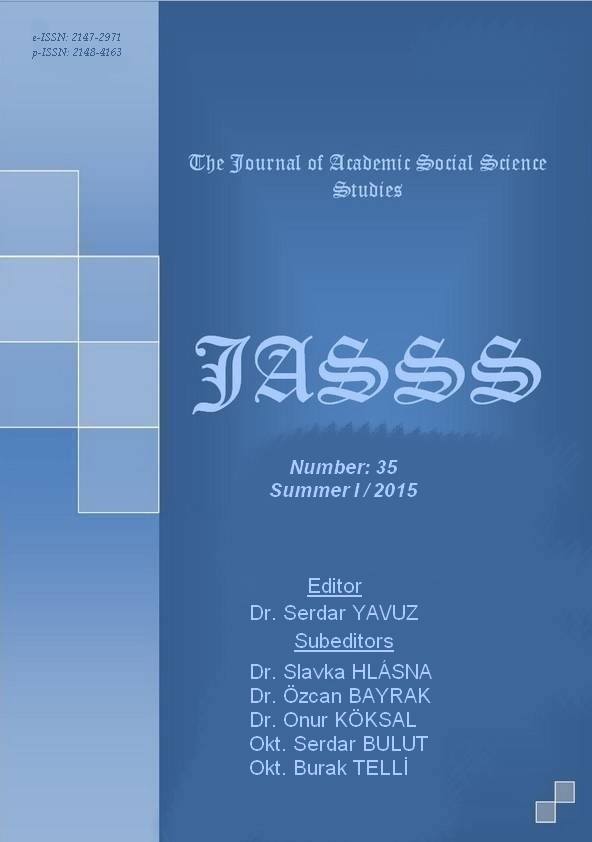EĞİTİM FAKÜLTESİNDE ÖĞRENİM GÖREN ÖĞRETMEN ADAYLARININ YARATICILIK DÜZEYLERİNİN ÇEŞİTLİ DEĞİŞKENLER AÇISINDAN İNCELENMESİ: ADÜ ÖRNEĞİ
Author :
Abstract
Günümüz yenilik ve teknoloji çağında yaratıcılık, topumun tümünden beklenen bir özelliktir. Toplumu şekillendiren öncelikli unsurlardan birinin de eğitim olduğu düşünüldüğünde eğitim kurumlarında yaratıcılığı geliştirebilecek ortamın sağlanmasının önemli olduğu düşünülmektedir. Yasa ve Şahin’e (2012) göre de öğrencilerde yaratıcı düşünmenin geliştirilmesi sürecinde öğretmene önemli roller düşmektedir. Öğretmenin bu rolleri yerine getirebilmesi için öncelikle kendisinin yaratıcılığı içselleştirmiş olması gerekmektedir. Bu nedenle öğretmen adaylarının yaratıcılık düzeylerinin ne olduğunun ve onların yaratıcılık düzeylerinin hangi değişkenlere göre farklılık gösterdiğinin oldukça önemli olduğu düşünülmektedir. Bu çalışmanın amacı Adnan Menderes Üniversitesi Eğitim Fakültesinde öğrenim görmekte olan öğrencilerin yaratıcılık düzeylerini belirlemek ve onların yaratıcılık düzeylerinin çeşitli değişkenlere göre farklılık gösterip göstermediğini ortaya koymaktır. Çalışmanın verileri, Adnan Menderes Üniversitesi Eğitim Fakültesinde öğrenim görmekte olan bin yirmi sekiz (K=711; E=317) öğrenciden toplanmıştır. Verilerin toplanmasında Raudsepp’in (1977) geliştirdiği ve Çoban’ın (1999) Türkçe’ ye çevirdiği “Ne Kadar Yaratıcısınız” ölçeği kullanılmıştır. Sonuçlar öğrencilerin yaratıcılık seviyelerinin ortalamanın altında olduğunu ve öğrencilerin yaratıcılık seviyelerinin onların bölümlerine göre anlamlı farklılık gösterdiğini ortaya koymuştur. Ayrıca öğrencilerin yaratıcılık seviyeleri ile onların sınıfları ve sanatsal etkinliklere katılma sıklıkları arasında da fark ortaya çıkmıştır fakat bu değişkenler için fark, anlamlılık derecesine oldukça yakın olmasına rağmen anlamlı değildir. Katılımcıların yaratıcılık düzeyleri ile onların cinsiyetleri, sınıfları, yaşları ve mezun oldukları lise türü arasında anlamlı fark bulunmamıştır. Sonuçlar literatür ışığında tartışılmış ve bu sonuçlara yönelik önerilerde bulunulmuştur.
Keywords
Abstract
Creativity is a crucial feature that is expected from all the members of the society in this era of technology and innovation. Since one of the prior facts that shape the society is education, it is important to obtain environments that develop creativity. According to Yasa and Şahin (2012) teachers have crucial roles to develop creative thinking of students. To perform these roles teachers should internalize creativity of theirselves. Therefore, it is important that the level of creativity of the teacher candidates and from which the levels of creativity of the teacher candidates differ. The purpose of the present study is to determine the levels of creativity of the pre-service teachers who get education from Adnan Menderes University Faculty of Education and also to investigate the difference between their creativity levels and various variables. Data was gathered from one thousand and twenty-eight students (F=711; M=317) who study at Adnan Menderes University Faculty of Education using “How Creative Are You” creativity scale, which was developed by Raudsepp (1977) and translated into Turkish by Çoban (1999). Additionally a personal information which was developed by the researcher was used. The results showed that creativity levels of the participants were below average and there was a significant difference between the creativity levels of the students and their departments. Also, there was a difference between the creativity levels of the students and their grades and their sequence of attending artistic activities. For these variables the difference was not significant, but very close to significance level. There was no difference between creativity levels of the students and their genders, ages and the type of the high school that they were graduated. Results were discussed with reference to related literature and some suggestions were made concerning the results.





